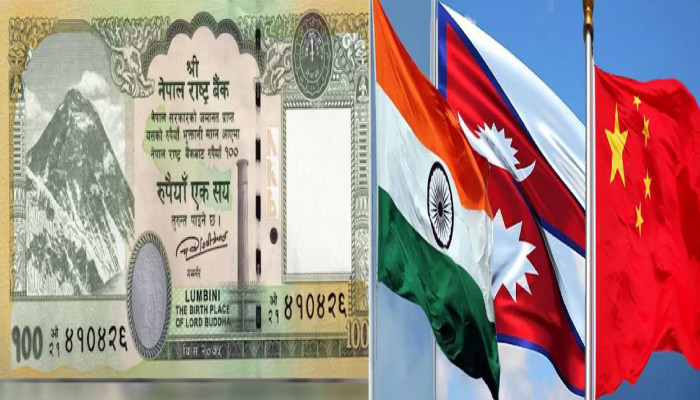Nepal awards contract to print redesigned currency notes to Chinese company escalating tensions
- In Military & Strategic Affairs
- 03:55 PM, Nov 02, 2024
- Myind Staff
Nepal has recently decided to redesign its 100-rupee note. This decision, however, has caused tension with India as the map on the new Nepali note includes border areas that are disputed between the two neighbouring countries.
China is indirectly influencing political and strategic tensions between Nepal and India. Recently, Nepal’s central bank, the Nepal Rastra Bank (NRB), awarded a contract to China Banknote Printing and Minting Corporation, a Chinese company, to design, print, and distribute 300 million copies of Nepal’s newly redesigned Rs 100 currency note. The estimated cost to print the currency notes is about $8.99 million, which means each note would cost around Rs 4.04 to produce. The new notes will feature an updated political map of Nepal, which now includes the disputed regions of Lipulekh, Limpiyadhura, and Kalapani.
Rekha Sharma, the minister of communications for Nepal, commented on the government's stance on the printing of these notes, saying, "The government has authorised the Nepal Rastra Bank to replace the current map on the currency note with an updated version." The decision was made in May this year under the government of Pushpa Kamal Dahal. After this, a formal tender process took place, and the NRB issued a letter of intent.
The Nepal-India border dispute dates back to the Treaty of Sugauli, signed in 1816 after the Anglo-Nepal War. This treaty set the Kali River as Nepal's western boundary, marking the land east of it—Lipulekh, Limpiyadhura, and Kalapani—as part of Nepal. However, since the 1960s, India has managed these areas. Tensions rose in November 2019 when India published a new political map that included these disputed areas within its borders. In response, Nepal issued its own updated map in May 2020, asserting these areas as Nepalese territory.
Foreign Minister S Jaishankar criticised Nepal’s unilateral action stating, “Our position is very clear. With Nepal, we are discussing our border matters through an established forum. In the middle of this, they have taken some unilateral steps on their part…But by doing something on their part, they are not going to change the situation or the ground reality between us."
Tensions between India and Nepal have been further strained as Nepal awarded a contract for printing its currency to a Chinese state-owned company. According to Republica, an English daily, China Banknote Printing and Minting Corporation was chosen through an open international tender. The decision has sparked concerns, particularly in light of the already delicate relations in the India-China-Nepal border area. Some observers in India believe that Nepal's government, led by Prime Minister Pushpa Kamal Dahal, might use the updated currency design to stir nationalist sentiments in Nepal.
According to the Kathmandu Post, Nepal's Foreign Minister Narayan Kaji Shrestha stated that he wished to engage diplomatically as he said, “We want to resolve the border issue with India. We want to fix it through diplomatic means and dialogue. We are taking initiatives for this." However, it is unclear if this will be sufficient to bring down the gap between the two nations.
India believes that the addition of Lipulekh, Limpiyadhura, and Kalapani to Nepal's currency is an attempt to assert territorial claims that would upset the balance between the two Asian countries. In May 2020, Nepal strengthened its claim over disputed areas after India opened an 80-kilometer road through Lipulekh, which connects Uttarakhand in India to Kailash Mansarovar in Tibet. This road is important for both trade and security, providing a convenient link from India to Tibet.
India has firmly opposed Nepal’s efforts to incorporate these areas into its territory, calling it an "artificial extension" of Nepal's borders and labelling the claim as false. The disputed land covers about 335 square kilometres. Although it’s a small area, its location at the tri-junction of India, Nepal, and China makes it strategically significant. Despite ongoing border tensions, Nepal and India maintain close ties through religion, culture, and strong economic connections. India is Nepal's top trading partner and has invested significantly in projects like hydropower.
However, without a diplomatic solution to the border issue, these relations may face challenges. Currently, both countries seem determined to hold their respective positions on the matter. Eight nations have given their currencies the name Rupee. Aside from India, these include Pakistan, Sri Lanka, Nepal, Mauritius, Maldives, Indonesia, and Seychelles. The Maldives uses Rufiyah, which is a modified variant of the Hindi term Rupee, as their currency, while Indonesia uses Rupiah.
Disclaimer: The opinions expressed within this article are the personal opinions of the author. MyIndMakers is not responsible for the accuracy, completeness, suitability, or validity of any information on this article. All information is provided on an as-is basis. The information, facts or opinions appearing in the article do not reflect the views of MyindMakers and it does not assume any responsibility or liability for the same.







Comments